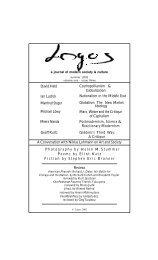Michael J. Thompson Stephen Eric Bronner Wadood Hamad - Logos
Michael J. Thompson Stephen Eric Bronner Wadood Hamad - Logos
Michael J. Thompson Stephen Eric Bronner Wadood Hamad - Logos
Create successful ePaper yourself
Turn your PDF publications into a flip-book with our unique Google optimized e-Paper software.
Ali Hossaini<br />
Photography represents the growing intimacy of humanity with machines.<br />
Tools originally amplified physical strength, but, with the advent of tools like<br />
the abacus, the compass and eyeglasses, they have been applied increasingly to<br />
mental faculties, giving us both modern media and digital computers. And<br />
recent advances in bioengineering are giving tools a quasi-organic status,<br />
merging them with our bodies. In 1950, biologist George Wald said<br />
photography was the product of convergent evolution:<br />
Of all the instruments made by man, none resembles a part of<br />
his body more than the camera does the eye. Yet this is not by<br />
design. A camera is no more a copy of an eye than the wing of<br />
a bird is a copy of that of an insect. Each is the product of an<br />
independent evolution; and if this has brought the camera<br />
and the eye together, it is not because one has mimicked the<br />
other, but because both have had to meet the same problems,<br />
and have frequently done so in the same way. This is the type<br />
of phenomenon that biologists call convergent evolution, yet<br />
peculiar in that one evolution is organic, the other<br />
technological. 3<br />
Wald then makes structural, mechanical and chemical comparisons between<br />
eyes and the photographic process. The similarities are numerous. Both use a<br />
lens to project an image within a dark chamber, both correct for aberrations<br />
in form and color, and both apprehend images through a grid of<br />
photosensitive receptors. As the capstone to his argument, Wald ends his<br />
essay with a discussion of optography, the art of making images with eyes.<br />
Willy Kuhne, a professor of physiology at the University of Heidelberg,<br />
invented optography in 1878. Kuhne was studying rhodopsin, the retinal<br />
pigment that changes state in response to light. During the course of his<br />
experiments, he realized that he might be able to take pictures with a living<br />
eye. He immobilized a rabbit and forced it to look at a window for three<br />
minutes. He then decapitated the animal, sliced open its eye, and soaked its<br />
retina in alum to fix the rhodopsin. The next day the dried retina revealed an<br />
image of the window. Two years later he repeated the process with the head<br />
of an executed criminal. The resulting optigram, which he reproduced in a<br />
drawing, is the only known picture taken with a human eye. Unfortunately,<br />
the scene it displayed was unidentifiable. (See Figures 2 and 3)<br />
<strong>Logos</strong> 2.3 – Summer 2003




